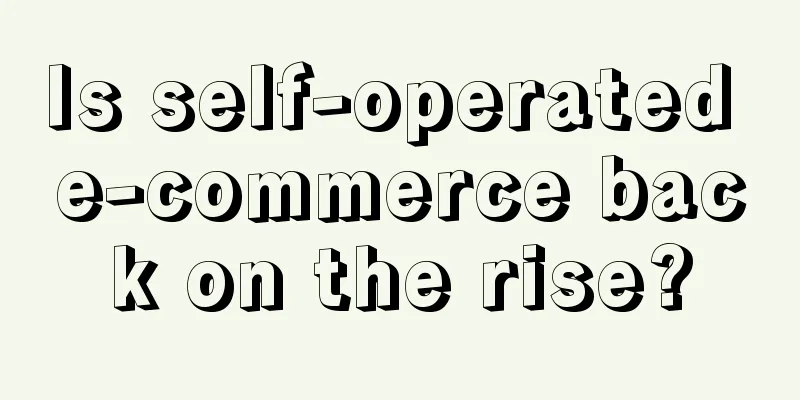Brand No. 1: Why the more anxious you are, the harder it is to grow

Yesterday, I spent 2 hours with 14 entrepreneurs on Tencent Conference to share questions about business growth. During the Q&A session, most of the questions that Lao Gao needed to answer were: How can I (my business) grow? In fact, how a company grows or how a company achieves growth (in the short term or long term) is not a tactical issue; it is an ultimate reflection on value and competitive space. In other words, the answer to the question of growth is not how, but why.
What are your answers to the three questions above? In fact, these are tools, indicators, and hows, not whys. 1. Answer the why questionDrucker was very firm in his view that "the most important point about any organization is that operating results only exist externally. The results of business operations are satisfied customers; the results of hospital operations are cured patients; the results of school operations are students who have learned something and can use what they have learned ten years later. As for the inside of the organization, everything is a cost. Marketing is about finding customers, connecting with customers, and building and deepening relationships with customers. Innovation is about making resources more valuable and providing customers with cheaper and better products. These are all things that satisfy customers, and they can feel the impact directly. That’s why Drucker said that companies only have two basic functions: marketing and innovation. The first question to answer for growth is why - the reason is simple, only satisfied customers will pay, and only then can the company achieve economic performance. In other words, when a company faces the problem of growth, it is first of all a big problem, a strategic problem, and more importantly, a problem of understanding and creating customer value. It is by no means a small problem, a product problem, a channel problem, or a ROI conversion problem. To answer the question of growth, we must first look beyond the product and think about what long-term value your company creates for customers, what is the unique differentiation of your company in the market competition, and what is the competitive niche you are operating in the long term. Products, prices, channels, promotions and even marketing are just tools, and the discovery of competitive niches is the core of answering the growth question. For Coca-Cola, it is authentic cola; for Pepsi, it is the choice of a new generation; for Midea air conditioners, it is frequency conversion; for your company, what is it? What is the unique and differentiated value created by your company - the competitive niche? Can you answer this question clearly and accurately? In other words: products, prices, channels, and promotions are all internal to the company, and the competitive niche is the company's understanding and insight into external value. How you understand value (competitive niche) determines how you create value (products, prices, channels, promotion).
For another example: For Mixue Bingcheng, this location is the ultimate cost-effectiveness created by the scale advantage of 10,000 channel stores (low price itself is not a strategy, the low price strategy based on scale advantage is the strategy). For Heyanyuese, which is also a milk tea brand, guarding Changsha is more valuable than fighting Wuhan, and becoming the representative of Changsha culture is an excellent position for Heyanyuese. From the perspective of industry, there are industry market price segments; from the perspective of categories, there are category differentiation and category characteristics; from the perspective of competition, there are previous waves and there will be more waves to come. Sun Tzu's Art of War says: If you know the place of battle, you can fight a thousand miles away on the day of battle. Knowing where to start a battle and choosing where to start a battle are more important than the action of starting a battle. 2. Answer the what questionWhat is not a product, but understanding users and consumer behavior. From the perspective of consumer behavior, describe the strength of the contact relationship between consumers and brands. Products are exchanged with consumers Brands are used to reach consumers For example, let's use a formula to explain this in detail. The basic logic of the business: Exposure X Click X Purchase X Average Order Value. Why solves the value problem of communicating with consumers (what to say), and what solves the problem of the object of communication with consumers (who to say it to): Please see the figure below for details. The figure below shows the coverage, reach, and conversion relationship formed by combining the AARR model with the 5A population. In fact, the use of the AARR model should be combined with the behavior of the crowd (consumer) to understand issues such as exposure and reach. Most of the reasons for poor reach are due to the understanding of the crowd. Of course, this is just an illustration. In fact, the stage of the brand, the scale of revenue, and other factors are the key to decision-making. In other words, the logic and objects of reach are different for different stages of the enterprise.
Brands expose, reach, interact, convert, settle, and activate target consumers by initiating actions (pictures, texts, short videos, advertisements, news, etc.). In this process, the behaviors of users are triggered from the exposed group, the shallowly interacted group, the deeply interacted group to the purchasing group and the fan users.
In the past, traditional brands used CCTV + celebrities to promote Nowadays, new consumer brands are using pictures/short videos + KOLs to promote The focus of seeding is different at different stages of growth, from brand origin to competitors, from categories to cross-categories, and then to scenarios. Through seeding at different stages, on the one hand, the seeding area is increased and the base of the exposed population is increased; on the other hand, the density of seeding is deepened, which can occupy the minds of users.
3. Answer the how questionWhat kind of products, at what price, what channel combination, and in what form should be promoted to potential target customers; what kind of content, scenarios, and KOLs should be used to reach potential target consumers. 1. ContentWhat is content? It is pictures and texts organized around the selling points of the product. For example, in the context of all milk brands working on natural pastures, adopting a cow starts with the cow, and the selling points are based on what kind of cow and what kind of milk it produces, and the selling points are highlighted by content around the cow's diet and daily life. for example:
2. ScenarioScene: A collection of people, time, place, and events. For example, being sleepy or tired is a scene, being a little hungry or sleepy is also a scene, eating hot pot and being afraid of getting a sore throat is a scene, and giving gifts during the Chinese New Year is also a scene. Scenario: People's needs are naturally awakened at a specific time and place, resulting in consumption events. For example: moon cakes are indispensable on the 15th of August, rice dumplings are indispensable on the Dragon Boat Festival, lively gatherings with relatives and friends are indispensable on the Spring Festival, and people always stock up on things on Double 11.
For example, busy young people work during the day, have coffee to refresh themselves, and snacks to relieve stress. At night, there seems to be no third choice except bars, KTVs, and cinemas. Therefore, a new bar built for young people, Helen's Bistro, was born. Helen's Bistro has become the midnight Starbucks for young people. It is currently the largest bistro in China and a bar where one can consume without stress. Young people nowadays always have indescribable pressure and need a pressure-free space to soothe their emotions. Helens provides a differentiated choice for young people in terms of cost-effectiveness and environment. 3. KOLKOL: Nowadays, a brand that doesn’t know how to promote products has no chance of being promoted. KOLs are trusted agents of new brands, active media players, and the shortest distance between consumers and brands. New consumer brands that can quickly become popular have undoubtedly found KOLs that match them. The logic behind choosing KOLs is the logic of brands sending signals to potential consumers. The signal source must be strong, the signal coverage must be large, and the signal must not be interrupted. The signal source must be strong: The KOL itself must have strong influence. A KOL with 1 million followers is different from a KOL with 100,000 followers; a vertical KOL is different from a non-vertical KOL. When choosing, you should first choose vertical and then general vertical. The more vertical the information source, the stronger it is. For example, Xiaoxiandun chose Zhang Yuqi, Zhang Ziyi, Jing Tian and other celebrities who are labeled as "lady" and "exquisite". While bringing high exposure to the brand, it also subtly established the credibility of Xiaoxiandun among potential consumers. Signal coverage should be large: Coverage is a measure of magnitude, and large coverage means trying to increase the magnitude as much as possible. This magnitude is best to be a phased magnitude under the same keyword. For example, Perfect Diary has achieved the ultimate in coverage. At most, I received 10 advertisements in a month, 4 of which were from Perfect Diary. "Cooperating with Perfect Diary is quick and easy. They pay directly without saying anything, which is very worry-free - said a Xiaohongshu blogger. In the early days, Perfect Diary put all its resources into Xiaohongshu. It built a pyramid-like layout: including top and mid-level influencers, as well as passers-by and ordinary people for large-scale advertising (top influencers for product endorsement, mid-level influencers for large-scale promotion, and passers-by and ordinary people for customer testimony). The lower the frequency of advertising, the more budget there is. The signal cannot be interrupted: the essence of long-termism is not to cross the big cycle, but to continuously penetrate the small cycle; it is an ability and action to cross the small cycle and see through the big cycle. Each small "peak" represents the new consumer brand that continuously transmits signals to consumers, traversing from products, brands, competing products, categories, cross-categories, and scenarios, and finally establishes a unique brand mindset. For example, the mature brand Feihe milk powder has long been conveying a core concept that it is more suitable for the physique of Chinese babies. Of course, this statement does not stand up to thought. Does it mean that foreign milk powder is not suitable for the physique of Chinese babies? Obviously, this is not the case. However, cognition is greater than facts, and signals cannot be interrupted. Repetition can establish cognition and then influence cognition. Author: Lao Gao (staying in Houshan) Source: WeChat official account: Lao Gao Business and Brand (ID: PPD6977) |
<<: Some thoughts on the incident of Manner employees throwing coffee powder
>>: 6 popular article templates on Xiaohongshu|Just follow them [Industry templates V3.1]
Recommend
Everyone loves Anthropic
Anthropic, an emerging AI research company, is gra...
Ten thousand words long article: Acquiring 200,000 customers in 70 days through MGM distribution fission
This article deeply explores the operating mechani...
What is eBay direct warehouse? What are eBay's logistics methods?
For eBay merchants, after opening a store, they ne...
In 2023, who will make a fortune in the beauty industry?
This article starts with the development of KOLs i...
Just ask on WeChat, and you will find that we can’t handle the free traffic!
This article mainly talks about the WeChat Ask fun...
Don’t use the logic of Tik Tok to create Xiaohongshu!!!
There are huge differences between the two platfor...
Douyin vs Xiaohongshu: In-depth analysis of the differences in the 5A marketing models of the two platforms
The 5A models of Douyin and Xiaohongshu are obviou...
What are the requirements for joining the Shopee cross-border e-commerce platform? What is the process?
Today, I will introduce you to the content of open...
Can ordinary sellers on Wish make money? How to register on Wish?
Wish is one of the four major cross-border e-comme...
How does Wish promote its products? Is the promotion effective?
As a world-renowned cross-border e-commerce platfo...
What are Amazon's virtual products? What are the virtual products?
Amazon can sell virtual products, but Amazon's...
How to remove promotional products from Shopee? How to check the listing status?
For Shopee merchants, they must pay attention to t...
Xiaohongshu group chat + live broadcast, the second battlefield in the private domain, doubled revenue
The mode of Xiaohongshu group chat + live broadcas...
Catching up with TikTok and Kuaishou, Tencent is adding short dramas to its products
The popularity of short dramas has soared recently...
How to do a good job in B-side business? After talking with several experts, I concluded four points
In recent years, the economy has been in a downtur...









